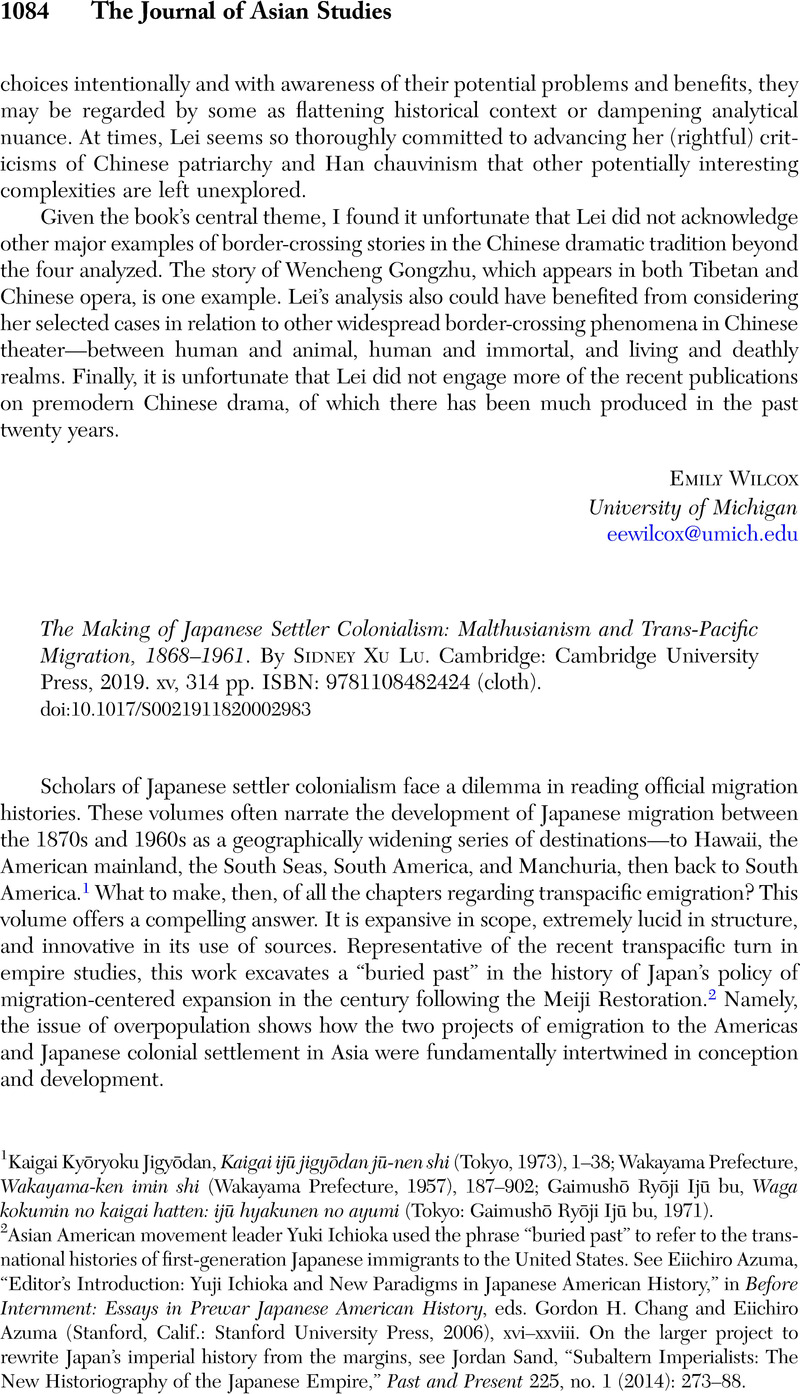No CrossRef data available.
Article contents
The Making of Japanese Settler Colonialism: Malthusianism and Trans-Pacific Migration, 1868–1961. By Sidney Xu Lu. Cambridge: Cambridge University Press, 2019. xv, 314 pp. ISBN: 9781108482424 (cloth).
Published online by Cambridge University Press: 16 December 2020
Abstract

- Type
- Book Reviews—Transnational and Comparative
- Information
- Copyright
- Copyright © The Association for Asian Studies, Inc., 2020
References
1 Jigyōdan, Kaigai Kyōryoku, Kaigai ijū jigyōdan jū-nen shi (Tokyo, 1973), 1–38Google Scholar; Wakayama Prefecture, Wakayama-ken imin shi (Wakayama Prefecture, 1957), 187–902; Gaimushō Ryōji Ijū bu, Waga kokumin no kaigai hatten: ijū hyakunen no ayumi (Tokyo: Gaimushō Ryōji Ijū bu, 1971).
2 Asian American movement leader Yuki Ichioka used the phrase “buried past” to refer to the transnational histories of first-generation Japanese immigrants to the United States. See Eiichiro Azuma, “Editor's Introduction: Yuji Ichioka and New Paradigms in Japanese American History,” in Before Internment: Essays in Prewar Japanese American History, eds. Gordon H. Chang and Eiichiro Azuma (Stanford, Calif.: Stanford University Press, 2006), xvi–xxviii. On the larger project to rewrite Japan's imperial history from the margins, see Sand, Jordan, “Subaltern Imperialists: The New Historiography of the Japanese Empire,” Past and Present 225, no. 1 (2014): 273–88CrossRefGoogle Scholar.
3 Since the mid-twentieth century, Japanese historians have made significant strides in the study of Japanese colonial expansion while focusing largely on domestic political and social contexts—notably, Hilary Conroy, The Japanese Seizure of Korea (Philadelphia: University of Pennsylvania Press, 1960); Akira Iriye, Pacific Estrangement: Japanese and American Expansion, 1879–1911 (Cambridge, Mass.: Harvard University Press, 1972); Louise Young, Japan's Total Empire: Manchuria and the Culture of Wartime Imperialism (Berkeley: University of California Press, 1998).
4 Takashi Fujitani, Race for Empire: Koreans as Japanese and Japanese as Americans during World War II (Berkeley: University of California Press, 2011); Emily Anderson, Christianity and Imperialism in Modern Japan (London: Bloomsbury, 2014). Japanese colonial studies has just as much to learn about mobility and identity from Japanese scholars of transpacific migration such as Kumei Teruko, Sakaguchi Mitsuhiko, and Shiode Hiroyuki as it has from Kimura Kenji's work on migration within the empire. Kimura Kenji, Zaichō nihonjin no shakai shi (Tokyo: Miraisha, 1989). See especially Kumei Teruko, Gaikokujin wo meguru shakaishi: kindai amerika to nihonjin imin (Tokyo: Yūzankaku, 1995); Sakaguchi Mitsuhiro, “Dare ga imin wo okuridashita no ka: kan taiheiyō ni okeru nihonjin no kokusai idō gaikan,” Ritsumeikan Gengo Bunka Kenkyū 21, no. 4 (2010): 53–66; Shiode Hiroyuki, Ekkyōsha no seiji shi (Nagoya: Nagoya Daigaku Shuppansha. 2015). For a good overview of the state of the field, see Yoneyama Hiroshi, “Nihonjin no kokusai idō to taiheiyō sekai no keisei: taiseiyōshi no kekka wo fumaete,” in Nihonjin no kokusai idō to teiheiyō sekai: nikkei imin no kingendaishi, eds. Yoneyama Hiroshi and Kawahara Fuminori (Kyōto: Bunrikaku, 2015), 3–13.
5 Whereas Lu's work has an institutional and discursive focus, Eiichiro Azuma takes a bottom-up approach to the role transpacific migrants played in the development of settler colonial projects. See Eiichiro Azuma, In Search of Our Frontier: Japanese America and Settler Colonialism in the Construction of Japan's Borderless Empire (Oakland: University of California Press, 2019).
6 The general lack of attention to transpacific emigration to the Americas as a force in the development of the Japanese Empire presents an opportunity for critique along the lines of Andre Schmid's 2000 review article about the absence of Korea in Meiji historiography. Schmid argued that it was essential for Japanese historians to place the history of the Meiji period in the context of “Japan's deepening colonial entanglements.” His critique largely remains implicit throughout the volume. See Schmid, Andre, “Colonialism and the ‘Korea Problem’ in the Historiography of Modern Japan: A Review Article,” Journal of Asian Studies 59, no. 4 (2000): 951–76CrossRefGoogle Scholar.
7 The open-access publication of this book was possible thanks to Michigan State University's participation in TOME (Toward an Open Monograph Ecosystem), an effort designed to widen the reach of excellent social science scholarship. This volume can be downloaded at https://www.cambridge.org/core/books/making-of-japanese-settler-colonialism/644DFDA740495E1C2D49B20CCF914418.





